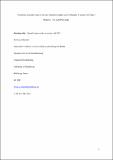Files in this item
Feasibility and pilot study of an intervention to support active lifestyles in youth with type 1 diabetes
Item metadata
| dc.contributor.author | Mitchell, Fiona | |
| dc.contributor.author | Wilkie, Louise | |
| dc.contributor.author | Robertson, Kenneth | |
| dc.contributor.author | Reilly, John J. | |
| dc.contributor.author | Kirk, Alison | |
| dc.date.accessioned | 2018-11-24T00:48:52Z | |
| dc.date.available | 2018-11-24T00:48:52Z | |
| dc.date.issued | 2018-05 | |
| dc.identifier | 251625592 | |
| dc.identifier | c46a5821-2573-4521-8c1a-729629a72e75 | |
| dc.identifier | 85045877865 | |
| dc.identifier | 000430921600016 | |
| dc.identifier.citation | Mitchell , F , Wilkie , L , Robertson , K , Reilly , J J & Kirk , A 2018 , ' Feasibility and pilot study of an intervention to support active lifestyles in youth with type 1 diabetes ' , Pediatric Diabetes , vol. 19 , no. 3 , pp. 443-449 . https://doi.org/10.1111/pedi.12615 | en |
| dc.identifier.issn | 1399-5448 | |
| dc.identifier.other | Bibtex: urn:c352986a53e544086cddd62121050ca7 | |
| dc.identifier.uri | https://hdl.handle.net/10023/16542 | |
| dc.description | This study was funded by Yorkhill Children's Charity. | en |
| dc.description.abstract | Background : Evidence suggests youth with type 1 diabetes (T1D) have lower levels of physical activity (PA) than the general population. The ActivPals intervention aimed to support youth with T1D to lead an active lifestyle. Methods : Twenty youth aged 7 to 16 years with T1D were recruited to a pilot randomized controlled trial. PA and quality of life (QoL) were measured using Actigraph GT3X+ monitor and Pediatric QoL scales at baseline and 1-month follow-up. A two-way, mixed ANOVA showed indicative effects of the intervention. Qualitative interviews were carried out with 16 participants to explore perceptions of the intervention. Results: An increase in moderate to vigorous PA was reported in intervention and control groups from baseline to follow-up (F(1, 14) = 5.83; P = .03), with no significance between group differences. Participants in both groups reported significantly less overall diabetes “problems” (F(1, 16) = 7.93; P = .012) and significantly less lifestyle “problems” (F(1, 16) = 7.39; P = .015) at follow-up. However, both groups also reported significant increases in “problems” with the day-to-day diabetes routine (F(1,16) = 6.48; P = .022) at follow-up. Parents reported significant increased worry about their child's diabetes at follow-up, in both groups (F(1, 14) = 5.83; P = .046). There was no significant increase in reported hypoglycemic occurrences despite increased PA. The qualitative data highlight that goal setting, self-monitoring, and social support were effective motivators for increasing PA. Conclusions: A larger trial with longer follow-up should be conducted to explore the effect of the intervention on PA in youth with T1D. | |
| dc.format.extent | 526271 | |
| dc.language.iso | eng | |
| dc.relation.ispartof | Pediatric Diabetes | en |
| dc.subject | Intervention | en |
| dc.subject | Physical activity | en |
| dc.subject | Type 1 diabetes | en |
| dc.subject | Youth | en |
| dc.subject | RA0421 Public health. Hygiene. Preventive Medicine | en |
| dc.subject | RJ101 Child Health. Child health services | en |
| dc.subject | NDAS | en |
| dc.subject | SDG 3 - Good Health and Well-being | en |
| dc.subject.lcc | RA0421 | en |
| dc.subject.lcc | RJ101 | en |
| dc.title | Feasibility and pilot study of an intervention to support active lifestyles in youth with type 1 diabetes | en |
| dc.type | Journal article | en |
| dc.contributor.institution | University of St Andrews. School of Medicine | en |
| dc.contributor.institution | University of St Andrews. Education Division | en |
| dc.identifier.doi | 10.1111/pedi.12615 | |
| dc.description.status | Peer reviewed | en |
| dc.date.embargoedUntil | 2018-11-24 | |
| dc.identifier.url | http://onlinelibrary.wiley.com/doi/10.1111/pedi.12615/full#footer-support-info | en |
This item appears in the following Collection(s)
Items in the St Andrews Research Repository are protected by copyright, with all rights reserved, unless otherwise indicated.

